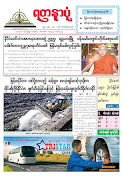Thanakha to protect ourselves from ultraviolet rays
= Shwebo Thiri Malar =
Even after the terrible Nagis cyclone school children were still fi ne-looking with Thanakha on their faces. Thanakha is cherished by all the people of every age, all walks of life and both genders in Myanmar. Once I met with a woman wearing Thanakha on her face while on a visit to the United States of America. When I asked her whether she was actually wearing Thanakha, she told me that she was a Myanmarborn Chinese living in the US, explaining that the beautifier she was wearing was called Myanmar Thanakha which had the power to beautify the skin and refresh the mind and body. “What a shame!” I said to myself as I was wearing makeup then.
My grandma always sang the song praising the virtues of Thanakha whenever she grinded it on a circular flat stone. When I grew older, I began to love Thanakha. I thought my grandma always wore Thanakha on her face. Thanakha was also a medicine for her that could cure many illnesses.
Not only the city damsels but also the female blue collar workers and paddy transplanters love Thanakha too. The former wear Thanakha just to added facial beauty, but the former wear it for many other purposes including as a sun-burn resistant agent. The Thanakha paste has the properties of making the skin cool and smooth, having a refreshing and cool fragrance, beautifying the users. It also cures pimples and acne.
When we applied cosmetics to enhance our appearance at a wedding ceremony, grandma always warned us to wash our face with water and soap as soon as we arrived back home. She said, “Cosmetics may have adverse effects especially on your face as they are made of chemicals.”
Really, wearing cosmetics for long hours make us feel bad. So we have to remove these agents from our skin and wear Thanakha again to make ourselves feel better.
There are many species of Thanakha, and of them Shwebo Thanakha is the most famous of its kind. Shwebo region is a dry land located in northwest of Mandalay. As Shwebo Thanakha trees grow on the dry land surface formed with red rocky soil in the region, they have a thicker bark when compared with other species and can produce more fragrant liquid or paste (Thanakha liquid) that we apply on our face and body. Actually, Thanakha, the fragrant liquid powder of the bark of Muraya Exotica, induced by rubbing it round and round with a little water on a circular fl at stone is a unique Myanmar traditional beautifier worn by Myanmar ladies, young and old alike.
According to Myanmar Thanakha compiled by U Tha Hla, the best known type of Thanakha during the reign of King Alaungmintaya was at Tabwet village on the west bank of Ayeywady River in KhinU township, Shwebo distrct. The court of that time acknowledged it as the Royal Thanakha.
The bark of Thanakha trees grew in the region was yellowish red in color. They were cut and sold at the court. But now the trees had already been rooted out, so that even a Thanakha tree the size of pointed finger is very rare to find.
Anyhow, Shwebo region is still renowned for its Thanakha that grows in its the red rocky soil. The color of Thanakha is ivory. It produces an aromatic Thanakha liquid that is rather sticky. Its taste is bitter than that of its cousins.
Shinmataung Thanakha is said to be worn by the queen of ancient city state Beikthano (Vishnu). Planted in the mid country, it is mostly used in the regions of lower Myanmar. Large plantations in Kyaukse, Pakokku, Taungdwingyi, Monywa, Ayadaw regions are producing Shinmataung Thanakha in huge quantities. It is whiter and less smooth than Shwebo Thanakha. As Shwebo Thanakha is smooth, aromatic and sticky, people who always wear it never wish to test any other kind of Thanakha. But the problem is that Shwebo Thanakha demand is much higher than the supply.
Large Thanakha trees can be found in Thabeikkyin, Tagaung and Kya-nyut at the east of Shwebo. Some call it Thihayaza Thanakha or Myaing Thanakha as they grow in Thihataw region. As the trunk is large, they are sawn and sold. When rubbed, they produce yellow Thanakha liquid that is less aromatic. But the liquid is sticky and smooth. Thanakha trees that grow in rocky soil have thicker bark that produces more Thanakha liquid than its cousins that grow in soft soil.
Some young women love to wear the sticky liquid produced from Thanakha roots. Mostly they produce yellow paste; some rub the roots together with shells. The paste is stickier and cooler than the paste from the barks. Its taste is bitterer and it is said to have higher level of medical properties.
Thanakha is grinding with machines to produce Thanakha cakes. One viss of cut Thanakha trunk can produce two viss of paste. We can get 0.8 viss of cakes when these two viss of substance were form into square-shape blocks and dried. Some people mixed other ingredients in making cakes. But pure Thanakha cakes are lighter than the ones mixed with other ingredients.
Cut Thanakha trunks are dried and then milled into powder. Thanakha roots produce yellow powder. Even young men applied Thankha power on their face as it protects the face from becoming oily.
There are also counterfeit Thanakha that is made from cut Thitpalway trunks which are similar to the real Thanakha trunks in appearance.
We the Myanmar women should use Thanakha instead of foreign-made cosmetics, as this practice can help cut foreign exchange expenditure of the state. Thanakha in reality is a natural substance that can refresh the mind and body and beautify the skin. What’s more it is aromatic.
#Themyawadydaily







































































































.jpg)




No comments:
Post a Comment